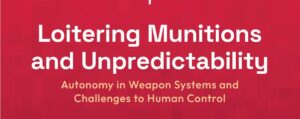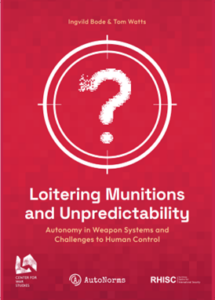Weapons Systems Data
Introduction
The AutoNorms project maps the design, development, and operation of weapons systems with automated and autonomous features over time. This includes qualitative data catalogues of different types of existing weapons systems as researched by the AutoNorms team, such as air defence systems and loitering munitions.
Autonomy and Automation in Loitering Munitions
Tom Watts & Ingvild Bode • June 2023
This catalogue has been created in conjunction with the Loitering Munitions and Unpredictability: Autonomy in Weapon Systems and Challenges to Human Control report published in June 2023. It provides information on the technical details, development history, and use of autonomy and automation in a global sample of 24 loitering munitions.
This catalogue has been constructed using a range of open-source material. This includes: (1) brochures, factsheets and other marketing material published by weapons manufacturers; (2) press releases and factsheets published by defence ministries; (3) media reports from reputable international news and defence outlets; (4) existing catalogues of weapons with autonomous and automated features; and (5) open-source intelligence presented on social media sites such as Twitter.
A detailed explanation of our case selection and research approach can be found in the fourth section of our accompanying report. Three methodological challenges should be kept in mind when reading our catalogue:
- There are gaps in the information which is publicly available on the technical design details and use of autonomy and automation in loitering munitions. We have neither observed the real-world testing and development of these weapons nor used them. As with other existing databases, our entries should thus be read as being more of an indicative rather than definite description of loitering munition development practices.
- Autonomy is a contested and politicised notion which has meant different things, to different actors, at different times. A review of the available open-source information on the use of “autonomy” to support mobility and targeting functions in loitering munitions can present vague and, at times, even contradictory findings.
- The weight given to the publicly available information on the technical capabilities of loitering munitions must be qualified by uncertainties regarding the Rules of Engagement under which these systems are operated. Whilst the systems included in our catalogue may have latent automated and autonomous features, we cannot claim to know whether these capabilities have been fielded.
Where possible, we have included an image of each of the 24 loitering munitions which make up our catalogue. When we have been unable to find any information about a particular system, we have marked the relevant section of the catalogue with NDA: No Data Available.
All references are provided as URLs and were accessible online as of 05/01/2023.
Spotted an error? Contact Us!
This catalogue has been made open access so that, if any of the information included in this document is incorrect, it can be corrected. If you spot an error in this catalogue, and would like to inform us of it, we can be reached at Thomas.watts@rhul.ac.uk
Funding
Research for this report was supported by a grant from the Joseph Rowntree Charitable Trust and by funding from the European Union’s Horizon 2020 research and innovation programme (under grant agreement No. 852123, AutoNorms). Dr Tom F.A. Watts’ revisions to this catalogue were funded by a Leverhulme Trust Early Career Research Fellowship (ECF-2022-135).
Acknowledgements
The authors would like to thank Guangyu Qiao-Franco and Anna Nadibaidze for their help researching the Chinese and Russian loitering munitions included in this catalogue. Any mistakes are our own.
Autonomy and Automation in Air Defence Systems
Tom Watts & Ingvild Bode • February 2021
This catalogue has been created in conjunction with the “Meaning-Less Human Control: Lessons from Air Defence Systems on Meaningful Human Control for the Debate on AWS” report published in February 2020 as a collaboration between Drone Wars UK and the Center for War Studies, University of Southern Denmark. It provides information on the system history, maximum system range, target type, system updates/variants and automated/autonomous features of twenty-eight air defence systems which have been operated by at least sixty states.
This catalogue has been constructed using a range of open-source material. This includes: (1) press releases and marketing material from weapons manufacturers; (2) press releases and factsheets published by defence ministries; (3) technical and policy reports authored by researchers based at think tanks; (4) Media reports from reputable international news and defence outlets; and (5) other air defence system databases. All references are provided as URLs and were accessible online as of January 2nd 2021. Please note: when information about a system has been unavailable, we have listed it as NDA (No Data Available).
In constructing this open-source catalogue, we have faced three methodological challenges worth briefly highlighting here:
- Many of the technical capabilities of air defence systems are not publicly available. Without having physically observed the testing and development of these systems, or been involved in their operation, we cannot be sure of their exact capabilities.
- Given the political sensitivities concerning the definition of autonomy, some of the open-source information which is available on the autonomous and automated features of air defence systems is vague and, at times, even contradictory.
- Whilst this catalogue has included information on the technical capabilities of air defence systems, this must be qualified by the uncertainty concerning the Rules of Engagement under which human agents use these systems.
A more detailed explanation of our case selection, catalogue index and research approach and limitations can be found in Section 3 of the accompanying report.
Spotted an error? Contact Us!
We have taken the decision to make this catalogue open-access so that, if any of the information included in this document is incorrect, we can update it accordingly. If you spot an error in this catalogue, and would like to inform us of it, we can be reached at Thomas.watts@rhul.ac.uk.
Funding
Research for this data catalogue was supported by grants from the Joseph Rowntree Charitable Trust and from the European Research Council under the European Union’s Horizon 2020 research and innovation programme (grant agreement No. 852123).

AutoNorms
An international research project examining weaponised artificial intelligence, norms, and order
Brows Research Themes
Recent Articles


Submission on Autonomous Weapon Systems to the UN Secretary General

The Imaginaries of Human-Robot Relationships in Chinese Popular Culture
Weapons Systems Data

Loitering Munitions Report Online Launch Event

